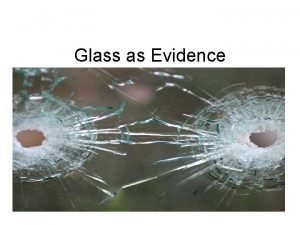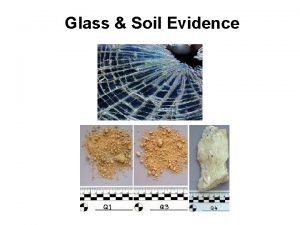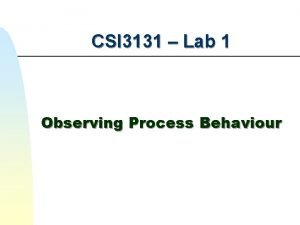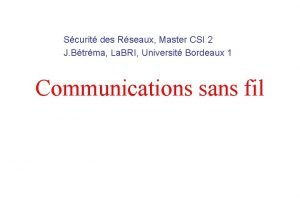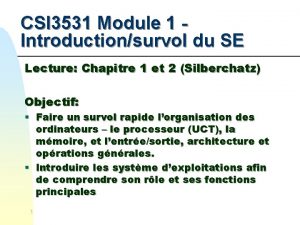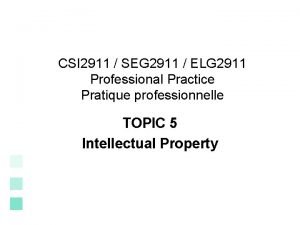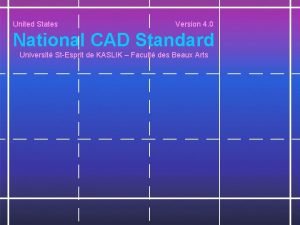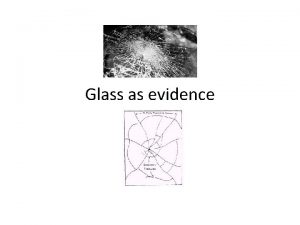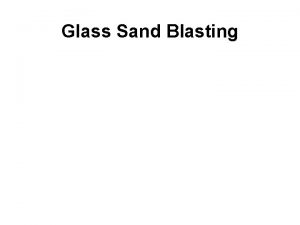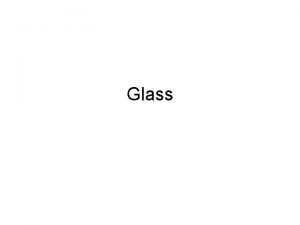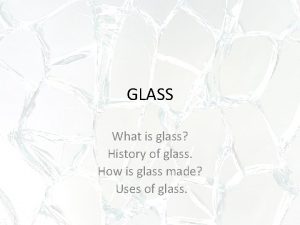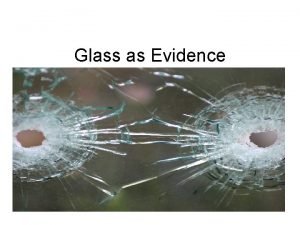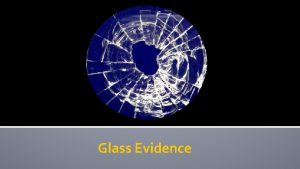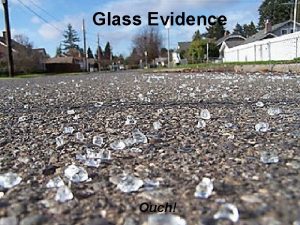GLASS AS EVIDENCE CSI Glass and Light Glass







































































- Slides: 71

GLASS AS EVIDENCE

CSI Glass and Light

Glass as Evidence

FBI’s Steps To Analyzing Glass At A Crime Scene

Step 1 Collection and Preservation of Glass

Collection and Preservation of Glass • The glass fragments should be packaged in solid containers to avoid further breakage. • The sample should be collected with consideration being given to the presence of other types of evidence on that sample (e. g. , fibers, blood). • The collector must consider that fragments within a questioned sample may have multiple origins.

Collection and Preservation of Glass • If glass evidence is to be pieced together, all glass must be collected. • If no fit can be completed, glass fragments must be submitted with reference samples found at scene. • When direction of impact need be determined, all broken glass must be recovered and submitted to the crime lab.

Considerations for Collection • The glass sample should consist of the largest amount that can be practically collected from each broken object and packaged separately. The sample should be removed from the structure (e. g. , window frame, light assembly). • When multiple broken glass sources are identified, it is necessary to sample all sources. • If the suspect’s shoes and/or clothing are to be examined for the presence of glass fragments, they should be individually wrapped in paper and transmitted to the laboratory.


Step 2 Make your initial examination.

Make your initial examination. • If possible, you'll want to determine the color, fluorescence, surface features, curvature, and thickness of the glass.

Step 3 Examine Fractures

Examine fractures. • • Are they radial or concentric? Was the glass broken from the inside or the outside? If there are multiple breaks which was first? A fracture match is an absolute means of identification.

Fractures Radial Concentric bsapp. com

How Does Glass Fracture? • Once glass reaches its’ elasticity point, it begins to crack. – Radial fractures develop first on the side opposite of the applied force – The continued motion of the force places tension on the front surface of the glass and results in concentric fractures – Examination of stress marks on the edges of the fractures reveals information related to the side on which the glass first cracked

Direction of Penetration Radial Concentric bsapp. com

Direction of Penetration A projectile hole is inevitably wider at the exit side bsapp. com

Forensic Fracture Analysis

Radial Begin at a point and radiate outward from point of impact Initial crack is on the side opposite the applied force

Concentric Circular lines around the point of impact Begin on the same side as the force

Sequencing § A high velocity projectile always leaves a hole wider at the exit side of the glass. § Cracks terminate at intersections with others. This can be used to determine the order that the fractures occurred. Kendall/Hunt Publishing Company 21

Sequencing • Which fracture came first? – You can determine the sequence of impacts by observing the existing fracture lines and their points of termination. – A fracture always terminates at an existing line of fracture.


Successive Penetrations st 1 nd 2

NOW YOU TRY Which one came first?

Practice 2

Practice 3

Practice 4

Stress Markings On Fractures A determination of the direction of force in breaking a window pane: direction of the rib marks [stress marks on broken edges of glass that are perpendicular to one side of glass]

Stress Markings On Fractures • Stress marks are shaped like arches that are perpendicular to one glass surface and curved nearly parallel to the opposite surface and are found on radial cracks. • The perpendicular end of the arch is always on the side opposite of the impact. • 3 R Rule: Radial cracks form Right angles on the Reverse side of the force

Fracture Patterns § 3 R rule—radial cracks form a right angle on the reverse side of the force.


Figure me out

Figure me out

You can use the fractures for Laminated Glass

You can’t use the fractures for Tempered Glass

Step 4 Measure the Density of the Glass Sample

Now measure the density of the glass sample. • If glass fragments are too small to be pieced together, they are identified by their densities and refractive indexes. – Only identifies glass to a common source: Class Characteristic • Density tells you something about the composition and thermal history of the glass.

Method 1: Flotation Method • Precise and rapid method for comparing glass densities. • Step 1: A glass particle is immersed in a liquid. • Step 2: The density of the liquid is carefully adjusted by the addition of small amounts of an appropriate liquid until the glass chip remains suspended in the liquid medium. • Step 3: The glass will have the same density as the liquid medium • Step 4: The glass can be compared to other relevant pieces of glass which will remain suspended, sink, or float.

Method 2: Immersion Method • Involves immersing glass particle in water and using the formula for density D=m/v • Step 1: Find the mass of the glass particle • Step 2: immersing a glass particle in water to get the mass of the water displaced • Step 3: Use the mass of the water displaced and the density of water to calculate the volume of water displaced • Step 4: The volume of water displaced equals the volume of the glass particle • Step 5: Use the mass and volume of the glass particle to determine the density of the glass

Density = m/v Type of Glass Density (g/cm 3) window 2. 46 -2. 49 headlight 2. 47 -2. 63 pyrex 2. 23 -2. 36 lead glass 2. 9 -5. 9 porcelain 2. 3 -2. 5 Kendall/Hunt Publishing Company 41

Step 5 Measure the Refractive Index of the Glass Sample

Index of Refractions Demonstrations

Measure the refractive index of the glass sample. • Refractive index is the most commonly measured property in forensic glass analysis. • It can give you the same information as density, but you only need a very small piece of glass. • Testing both density and refractive index tells you more than just checking one or the other.

RI Variation for Glass • Glass shows very little variation in RI • Not a conclusive test for source • Variation is decreasing with modern manufacturing

Decreasing Variation 1964 -1997 1980 -1997

So why use refractive index? • For the times that the glass in your sample is “rare” • This makes your match more conclusive • Example: the glass found in the crime scene is only made by one manufacturer

Immersion Method for Refractive Index • Refractive index is compared by an immersion method. – Glass particles are immersed in a liquid whose refractive index is varied until it is equal to that of the glass particles. – At this point, called the match point, the observer will note the disappearance of the Becke Line and the glass will seem to disappear. • Becke Line: a bright halo that is observed near the border of a particle immersed in a liquid of a different refractive index.

The Becke Line The Becke line is a “halo” that can be seen on the inside of the glass on the left, indicating that the glass has a higher refractive index than the liquid medium. The Becke line as seen on the right is outside of the glass, indicating just the opposite.

Why do Becke Lines Appear? Becke lines are the result of two things: 1. The fact that glass in thin sections tend to be thicker in the center and thinner towards the edges, thus they act as lenses 2. The indexes of refraction of the glass and the oil are different. This causes the light to bend and form a halo. Both criteria together form Becke lines

Becke Lines Becke lines can be found inside or outside of the glass particle Outside Inside The location of the Becke lines depend on the RI of the oil, RI of glass, and the focus of the microscope, whether it is focused up or focused down.

Why We See Becke Lines

Which Liquid has the closest refractive index?

Using a microscope to determine refractive index § This occurs in an apparatus called a hot stage which is attached to a microscope. § The refractive index of a high boiling liquid, usually a silicone oil, changes with temperature § The sample is placed in the oil on the hot stage and the increasing the temperature allows the disappearance of the Becke line to be observed § At match point, temperature is noted and refractive index of the liquid is read from a calibration chart

Relief • When we observe different glass fragments, some stand out more than others. • This is known as relief. • Relief is an optical property that describes how well a material can be seen and distinguished from its surroundings.

Degrees of Relief The greater the difference in refractive index, the more the light is bent and the greater the relief The lower the relief, the closer you are to a match in the refractive index between the glass and the oil.

If the immersion medium is changed, the relief will also change • When a mineral is immersed in liquids with a different refractive index, its relief will change even if it remains in the same position.

Refractive Index Liquid RI Glass RI Water 1. 333 Vitreous silica 1. 458 Olive oil 1. 467 Headlight 1. 47 -1. 49 Glycerin 1. 473 Window 1. 51 -1. 52 Castor oil 1. 82 Bottle 1. 51 -1. 52 Clove oil 1. 543 Optical 1. 52 -1. 53 Bromobenzene 1. 560 Quartz 1. 544 -1. 553 Bromoform 1. 597 Lead 1. 56 -1. 61 Cinnamon oil 1. 619 Diamond 2. 419 Kendall/Hunt Publishing Company 58

Automated Refractive Index Determination What the professionals use.

Automated RI Systems • GRIM 3 – Glass Refractive Index Measurement

GRIM measurement technique • Silicon oil usually used • Oil is calibrated so RI of the oil can be determined from its temperature • Sample glass is immersed in oil • Oil is heated/cooled to determine match temperature – Point at which the glass “disappears” • Oil RI = Glass RI

GRIM II identifies the RI match by monitoring a video image of the glass fragment in the liquid -as it is heated/cooled the contrast is measured until a minimum is reached-the match point


Step 6 Determine major, minor, and trace elements in the glass

Determine major, minor, and trace elements in the glass. • These methods are destructive methods so the FBI recommends measuring density and refractive index first • Determine the percent of each element in a sample using scanning electron microscopy, X-ray fluorescence spectrometry, inductively coupled plasma-optimal emission spectrophotometry, inductively coupled plasma -mass spectrometry, laser ablation-inductively coupled plasma-mass spectrometry, or atomic absorption spectrophotometry to determine the

More on Trace Analysis of Glass • Another method results from the fact that glass surface develops unique scratches and abrasions from repeated wear and tear. – For example, the glass windshield of a car might develop tell-tale scratches from wiper blades with embedded grit or other minute objects. These patterns can be used to reconstruct the windshield. •

How Trace Analysis Can Be Used

Extra Slides

Forensic Individualization of Glass Types • Flat Glass–Soda lime silicate -Rolling or Floating – Tempered: Rapid Cooling • • Adds Strength Dices when broken Automotive windows & security windows Float Glass floresces when excited at 254 nm.

Forensic Individualization of Glass Types – Coated: Surface modification • Mirrors – Laminated: Sandwiched around plastic • Automotive windshields – Headlights: often borosilicate – Light bulbs: soda lime glass – Heat absorbing/ UV filtering • tinting – Eyeglasses: prescription lenses/photosensitive

Forensic Individualization of Glass Types • Container Glass – Lower magnesium, higher sodium – Clear vs. greenish (window) • Glass Fibers – Fiberglass insulation – Alumino-borosilicate – Binder (red or yellow) to hold fibers in bundles
 Light light light chapter 23
Light light light chapter 23 Light light light chapter 22
Light light light chapter 22 Chapter 22
Chapter 22 Class evidence can have probative value.
Class evidence can have probative value. Primary evidence vs secondary evidence
Primary evidence vs secondary evidence Primary evidence vs secondary evidence
Primary evidence vs secondary evidence Primary evidence vs secondary evidence
Primary evidence vs secondary evidence Primary evidence vs secondary evidence
Primary evidence vs secondary evidence Primary evidence vs secondary evidence
Primary evidence vs secondary evidence Fiber evidence can have probative value.
Fiber evidence can have probative value. Class evidence vs individual evidence
Class evidence vs individual evidence Class and individual evidence
Class and individual evidence Example of fallacy
Example of fallacy Put out the light and then
Put out the light and then Leucoplast double membrane
Leucoplast double membrane The bouncing off of light
The bouncing off of light Law and order vs csi
Law and order vs csi Csi computer crime and security survey
Csi computer crime and security survey Light is a particle evidence
Light is a particle evidence Becke line
Becke line Glass evidence in forensic science
Glass evidence in forensic science Can light block light
Can light block light Csi 3120
Csi 3120 Csi3120
Csi3120 Csi 321
Csi 321 Csi in project management
Csi in project management Two people can have identical handwriting.
Two people can have identical handwriting. Csi varese
Csi varese Csi framework
Csi framework Rts5880
Rts5880 Unicode space 3140
Unicode space 3140 Csi 3140
Csi 3140 Csi 3140
Csi 3140 Csi 3140
Csi 3140 Csi 3131
Csi 3131 Csi 2911
Csi 2911 Elg2911
Elg2911 While the csi team is searching the crime scene, _____.
While the csi team is searching the crime scene, _____. Csi great lakes region
Csi great lakes region Bnl csi
Bnl csi Csi uottawa
Csi uottawa Csi corporate card
Csi corporate card Mario bieringer
Mario bieringer Csi dinner edition answers
Csi dinner edition answers Csi 2132
Csi 2132 Pnr curve in software engineering
Pnr curve in software engineering Master csi
Master csi Cara menghitung csi
Cara menghitung csi Bricscad plugin
Bricscad plugin Distinte csi bergamo
Distinte csi bergamo Csi 3531
Csi 3531 Csi 3140
Csi 3140 Csi 3140
Csi 3140 Csi 2911
Csi 2911 Inference rules
Inference rules Csi la molina
Csi la molina Www pge com standardnem
Www pge com standardnem Cousin word scramble
Cousin word scramble Uds cad
Uds cad Katrin csi
Katrin csi Csi
Csi A csi lab technician _____.
A csi lab technician _____. Csi 3140
Csi 3140 Csi 3140
Csi 3140 Csi 3131
Csi 3131 Csi 2510
Csi 2510 Crime scene search patterns examples
Crime scene search patterns examples Epbb calc
Epbb calc Boston massacre crime scene
Boston massacre crime scene Amir afrasiabi
Amir afrasiabi Csi cable jamestown
Csi cable jamestown Continual service improvement 7 steps
Continual service improvement 7 steps



















